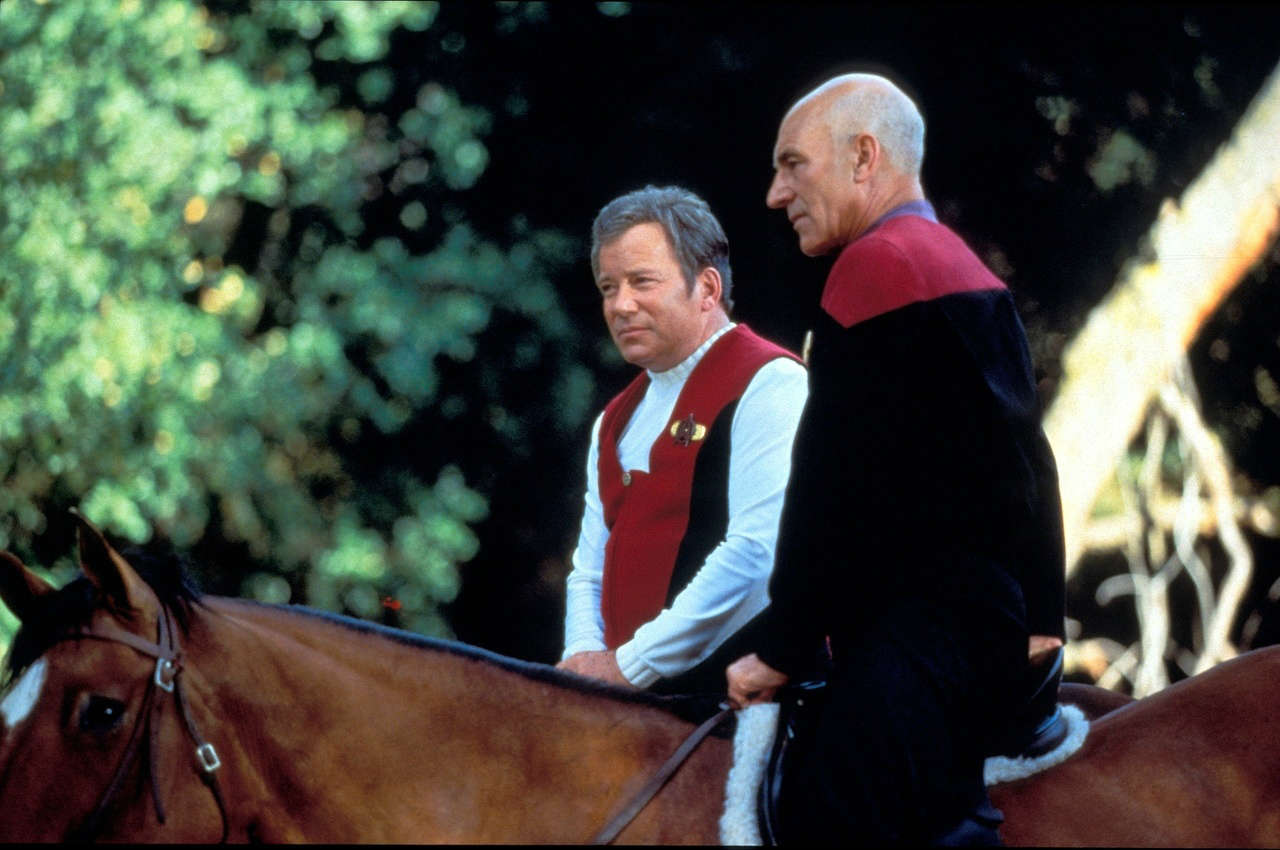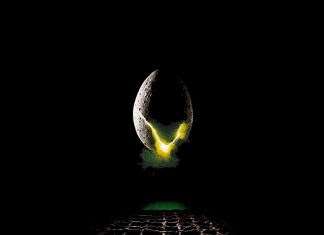Star Trek Generations has been a thorn in my side for years. I’ve had many arguments with its defenders (and there is no one more reliably outraged than a Trekkie) who lazily point to The Final Frontier or Nemesis as being even worse. Neither of those are much good, to be sure, but Generations is surely the crowning turd in the Trek pool.
In 1994, Star Trek: The Next Generation went off the air with an exceptionally strong series finale, ‘All Good Things’. After seven years of steadily-increasing quality and ratings, Paramount decided to cook their golden goose and serve it up in theatres.
The aged Original Series crew would be replaced after six movies of variable quality but had, after 25 years, acquired an almost unrivalled reverent affection from fans.
At the earliest stages of development, the first Next Gen feature was to have been nothing less than a STAR TREK gangbang. The two crews would meet and the perfect scenario would have found them at odds.
In the words of writer Ron Moore, “The best possible poster you could ever hope to have for this movie would show you the two Enterprises battling each other…but we were never able to come up with any scenario that made both crews look heroic”.
The solution was instead to have a story that started in Kirk’s era and ended in the Next Gen era, allowing Captain Kirk (William Shatner) to jump forward in time via a temporal MacGuffin called the Nexus and meet Captain Jean-Luc Picard (Patrick Stewart). And to provide a solid-gold USP, Kirk would be killed off.
For Paramount, here was a win-win movie. The Next Gen crew would be given go-faster cinematic stripes, and one of the most iconic pop-culture icons of all time would literally be buried by his successor.
Thus, here was a TREK movie that would be nothing less than a must-see classic: Kirk + Picard = PROFIT.
Except it wasn’t, and Generations wet-farted its way into theatres to a middling box office and indifferent reviews.
In fact, there’s a very strong case for this being the worst of all of the STAR TREK movies. It’s simply a shambles from start to finish – ineptly scripted, boringly filmed, tediously unfunny and thunderingly uninspired.

The Story
In some ways, Generations isn’t even a movie. It’s a visual document of a piece of dutiful corporate-succession planning, and the film oozes this process from its pores. Starting with Kirk, Scotty and Chekov seeing the next-in-line Enterprise-B off on its maiden voyage, Kirk vanishes into a glowing plot device, presumed dead.
75 years later, the Next Generation crew makes a bid to convince a wider audience that they’re a wacky bunch of space dudes to hang with by farting about on a sailing ship.

Data (Brent Spiner) immediately casts himself as the “what does it mean to be human?” archetype that features in, oh, every sci-fi series ever and Picard is immediately and pointlessly plunged into a depression from which he never really comes out for the rest of the movie. We having fun yet?

Responding to a distress call from a space station (which exist in these franchises purely for the purpose of being attacked), they discover Soran (Malcolm McDowell, of British Villains Incorporated). Soran is a mad scientist in league with some Klingon ho’s that no one remembers from the series, and is blowing up stars in order to move the glowing plot device towards some scaffolding.
Picard grumblingly gets off his depressed French ass and runs into Kirk in the paradise dimension of the Nexus. The two greatest captains in the galaxy chop some wood, cook an omelette and ride horses.
Then they have an arthritic fight with Soran, Kirk winds up stuffed into a rock crevice, Picard delivers a ponderous moral that wouldn’t be out of place in an episode of He-Man and Data cries over a fucking moggy. Qapla’!

TV to Big Screen
The accusation that “it’s just an extended TV episode” can be levelled at every one of the Next Generation movies, but it was never truer than it is here. Star Trek Generations was filmed less than two weeks after the series wrapped, and it shows.
While 1979’s Star Trek: The Motion Picture emphasized the jump to the big screen with a beautifully re-designed USS Enterprise, state-of-the-art visual effects and expensive sets, the poor Next Gen chumps were literally walking around the same sets in the same clothes. Except, in a truly inspired move, they turned the lights waaaay down in the hope the audience wouldn’t notice how shonky the sets looked on a big screen.
Thus, throughout the film Picard barks orders on a dull bridge suffocating in orangey-black shadows, while to save a few more pennies, effects shots are lifted not only from previous movies but from the TV show.
David Carson, a director drafted in from the series (“who needs a big name, dudes, we can do this in-house for fuck-all!”) is unable to either frame or shoot cinematically. He would trouble the box office only twice more, his last movie being a 2004 Wesley Snipes flop. The one memorable image from the film (Soran’s sky-grab at the Nexus) practically films itself.
Roger Ebert, perceptive as always, didn’t fail to notice that one scene (involving Data essentially laughing himself into a coma), is so badly-directed that the audience has no idea whether it’s meant to be funny or not.
The lazy cheap-assed recycling also extends to a key action set piece, which is outrageously lifted wholesale from Star Trek VI: The Undiscovered Country. In that movie, the Enterprise is helplessly pounded by a Klingon Bird of Prey with a tactical advantage, until someone comes up with a way to beat it, and the villains watch as a torpedo slowly streaks towards them.
And here? The Enterprise is helplessly pounded by a Klingon Bird of Prey with a tactical advantage, until someone comes up with a way to beat it, and the villains watch as a torpedo slowly streaks towards them.
Oh, and for good measure, the shot of the Klingon Bird of Prey exploding is the EXACT SAME ONE from the previous movie.
Adding insult is the fact that despite being a far more advanced and powerful ship, the Enterprise inexplicably only fires back once. Commander Riker (Jonathan Frakes) simply sits there gormlessly and ignores the fact that he could just blow the Klingons out of the sky with a barrage of phasers and torpedoes.
The Enterprise is therefore ignominiously taken out by the space equivalent of a Scud missile and crashes in a noisily-spectacular but emotionally-meaningless effects sequence.
Now, compare that to Star Trek III: The Search For Spock and to Kirk standing on Genesis with his friends, watching his sacrificed ship – his whole LIFE – gracefully falling to its burning death across the sky, and whispering, “My God, Bones. What have I done?”

You take my point.
The fact is that when this Enterprise gets totalled, it carries zero weight because we know there’s a new one waiting in the garage and more movies to come. When The Voyage Home revealed the Enterprise-A, it was a genuine surprise – people cheered in my theatre.
Nexus, Schmexus
I hear lots of talk about the plot holes in the Abrams movies – and they are there. But they’re as nothing compared to the colossal wormholes of logic here, most of which involve a plot device invented purely as a conceit for the two captains to meet, and otherwise makes no sense at all.
The Nexus is a paradise dimension entered via a twisty glowing space ribbon. Kirk is sucked into it and presumed dead – and apparently everyone in Starfleet promptly forgot about it. 75 years later it’s referred to as “some kind of energy ribbon”. No one bothered to investigate what killed the galaxy’s greatest hero?
Fundamentally though, the problems with the Nexus go beyond nitpicking. There is no movie featuring time travel which holds up under scrutiny. But this falls apart in under five seconds.
Soran’s plan to move the Nexus by destroying stars because “it’s the only way” immediately crumbles because of the fact he got in via a ship in the first place (and although a feeble effort is made to counter this, it doesn’t work).
Picard plans to exit the Nexus to just prior to the moment when Soran destroyed the star. Why not go back days earlier and shoot the bastard in the head instead of giving yourself five minutes?
We’re told that “time has no meaning” in the Nexus and the only way to leave it is if you really want to. Which means that once Soran’s in, he’s in. He can’t be pulled out again just by Picard going back in time. He’s still there now.
The Villains
Ah, we’ve had some great villains in STAR TREK haven’t we? Khan. Kruge. Chang. The Borg Queen. And, er, no, that’s it.
Soran himself is entertainingly played by a ham-laden Malcolm McDowell but is barely sketched. In the 75 years since his first encounter with the Nexus, there is no explanation as to why he has become a homicidal madman other than…he just is. Guinan (Whoopi Goldberg) says he’s “obsessed”, but there is no explanation as to how she possibly knows that. He’s as much a plot device as the Nexus itself – his character is as empty as space.
The writers also took the unfathomable decision to have Soran in league with a pair of Klingon sisters that featured in a couple of Next Generation episodes. To anyone who didn’t happen to see those episodes, these characters are a total mystery. There is no context given or anything for the audience to connect to. They’re simply a pair of cackling pantomime dames – all tits, teeth and snarls.

The “no problem that can’t be solved if we fuck around with the pulse emitters to create an inverse tachyon neutrino subspace graviton beam” Syndrome
Here is possibly my biggest problem with STAR TREK, and specifically the writing from the TNG era onwards.
Technobabble relating to fictional technology is an inevitable part of science fiction. But here’s the thing – there’s a way to keep it relatable to an audience. Take the Genesis device from The Wrath of Khan. It creates a new planet from a dead one. That’s all you need to know.
From Next Generation onwards and into Deep Space Nine, Voyager and Enterprise, the writers assumed that guffclouds of nonsensical techno-shite constituted great dialogue. In this and the subsequent movies, we were gifted with “metaphasic radiation”, “thermolytic reactions”, “interplexing beacons” and “cascading biogenic pulses”.
Generations doesn’t quite step over the mark, but there are still snippets of techno-dialogue that any decent script editor would have polished up. The Enterprise-B’s helm officer pointlessly throws out that there “are fluctuations in the warp power relays”. Don’t know about you, but I was on the edge of my seat – shit’s getting real!
This thrilling script gives us “gravimetric distortions”, “ruptured magnetic interlocks” and “level 12 shockwaves” galore. Why level 12? How about “a massive shockwave”? It does the job, guys.
Remember how they found the invisible Bird of Prey in The Undiscovered Country? They tracked its exhaust trail. The concept is easy to understand, clever – and relatable.
In the identikit action sequence here, the crew babble about “defective plasma coils being susceptible to some kind of ionic pulse”. Difference? No one knows what they’re talking about, and thus without any frame of reference the resolution carries no impact for the audience.
The Stakes
Let’s think back to some of the previous Trek movies. The Motion Picture, for all its faults, at least came up with an awe-inspiring threat. In The Wrath of Khan, Khan gets his hands on Genesis and Spock dies. In The Search For Spock, the Enterprise – the vehicle for every TREK adventure – is no more. Earth is plunged into permanent darkness by a whale-obsessed probe in The Voyage Home. The wall comes down in space in Trek VI (let’s ignore V).
What have we here? Picard and Kirk must save the lives of millions of “pre-industrial humanoids” – cavemen – who are never even shown on-screen. The audience is again left with absolutely no context or connection to the stakes supposedly powering the engine of the movie.
The Trouble With Niggles
Let’s rattle through these, because the writing is so poor that there is hardly a moment in this film when something completely illogical doesn’t make you say, “hang on, why is..?”
From the start, the Enterprise-B is being commanded by Captain Harriman (Cameron from Ferris Bueller’s Day Off) who, within five minutes, is revealed to be an incompetent chump. How this man even managed to put his pants on without help is a mystery – yet he is inexplicably commanding the flagship of the fleet.

The Enterprise-B takes a publicity spin around the solar system for its maiden voyage and is then revealed to be the “only ship in range” able to respond to a distress call. Where was everyone, did they just run away when Harriman wasn’t looking to drop him in the shit?
The comedy here goes down like a fucked lift and is played so slapstick-hard that it wouldn’t pass muster in a kids’ cartoon. There isn’t one attempt at getting laughs that doesn’t fall completely flat.
Kirk and Co. are handed some wince-inducing stuff in the first 10 minutes about how the ship is lacking any extras, but most of the comedy is mined from Data getting an emotion chip and then turning into a clown and a pussy, in that order. Data’s sub-plot has literally nothing to do with the movie happening around him and it was a shift in the character so embarrassing that the subsequent movies did their best to ignore it.
A ham-fisted attempt is made to give Picard an “arc” by killing his brother and nephew off-screen, forcing him to spend half the movie grieving over two characters no one cares anything about. Great intro to the big screen, guys!

Kirk is apparently tempted to stay in the Nexus by Antonia, a long-lost love. Nope, me neither. Hadn’t the writers heard of Carol Marcus, or Edith Keeler? Y’know, women who meant something to him and that the audience might just remember? Guess not.
And Kirk’s death? An insultingly flippant end to the character. He plunges off a cliff, dies quickly to some indifferent music, and that’s it. Except that even this was their second attempt at getting it right – the entire last act was re-shot following negative audience reaction to the original death scene, which simply saw him shot in the back.
The Legacy
The sad fact is that the Next Generation crew went from an intelligent and often brilliant TV show to being shafted by their movies. While Star Trek: First Contact seemed to put things back on track with a fun, character-driven action movie, Insurrection would find Troi and Crusher talking about their tits firming up, Picard singing karaoke and Riker using a joystick, before Nemesis buried the franchise for eight years.
Generations hobbled them from the start. Instead of the must-see TREK epic we expected, a collection of TV people fumbling their way into the movies made a cheap catastrofuck that embarrassed as much as it depressed.
For many, TREK has never really recovered. 2009’s Star Trek was, for me, a damn entertaining movie, but the fatuous Into Darkness shot a fatal hole into the repaired Enterprise. Star Trek: Discovery may have its own merits (and it does), but the logic of even calling it “Star Trek” for anything other than commercial reasons seems like a hell of a stretch at this point.
But Generations? Boldly, don’t.
Be lucky,

DiamondJoe
Check out some more of my retro reviews here:
EXORCIST II: THE HERETIC Review
AN AMERICAN WEREWOLF IN LONDON Review : I Used To Be A Werewolf, But I’m Alright Noooooowww
HULK (2003) Review : Its Not Easy Being Green
ALIEN RESURRECTION Review : Ripley, Believe It Or Not
KRULL Review : A Rave To The Glaive
[amazon_link asins=’B000JINWNK,B016OLA1B6′ template=’ProductCarousel’ store=’filmgoblin-20′ marketplace=’US’ link_id=’dc6f4b38-1686-11e8-af90-c501b2d82bcc’]









